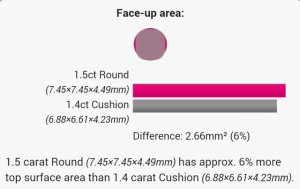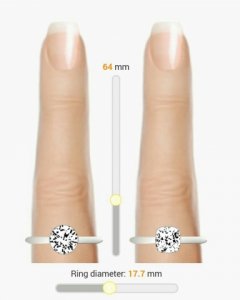I like to know if it's good practice or safe practice to use surface area calculation to determine face-up size view?
for example, I like the size of 1.5 carat round brilliant (most are 7.47 x 7.47mm). So if we take this dimension and find the surface area (face up view), we would get: A=pi * r^2 = (7.47/2)^2 * pi = 43.803mm^2.
Now my girlfriend likes cushion cuts. To achieve the same look, I found a cushion cut that is 1.40 carat, 6.88 x 6.61. But this is cushion so it's more square. Therefore, we can just do length * width = 45.4768mm^2.
So even though the round brilliant is larger in diameter, would the cushion cut look bigger (from a face up perspective) just because it has more surface area mass?
Thanks
for example, I like the size of 1.5 carat round brilliant (most are 7.47 x 7.47mm). So if we take this dimension and find the surface area (face up view), we would get: A=pi * r^2 = (7.47/2)^2 * pi = 43.803mm^2.
Now my girlfriend likes cushion cuts. To achieve the same look, I found a cushion cut that is 1.40 carat, 6.88 x 6.61. But this is cushion so it's more square. Therefore, we can just do length * width = 45.4768mm^2.
So even though the round brilliant is larger in diameter, would the cushion cut look bigger (from a face up perspective) just because it has more surface area mass?
Thanks









300x240.png)